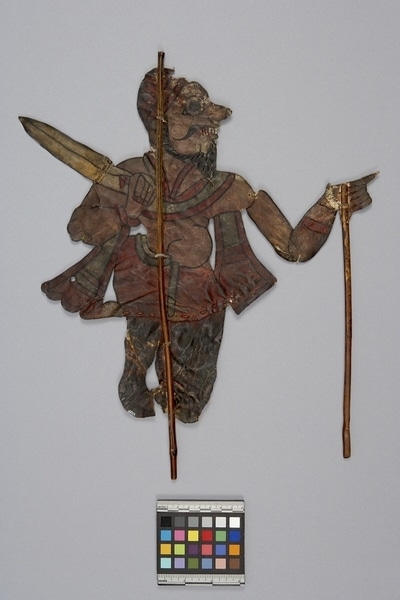Shadow Puppet Item Number: Ef218 from the MOA: University of British Columbia

Description
A shadow puppet of transparent cut out leather representing the figure of a male human. Has one large black circular eye, a black moustache, sideburns, and beard. Has a big nose, and a bulging stomach. Wearing a red hat. There is a red, and green sash (?) tied around his neck. Wearing a red, and green lower garment. One hand is holding a pointed object. Has a split bamboo stick up the centre tied in three places. One moveable arm is jointed, and tied with thread at the shoulder, and elbow, the hand to which has a second bamboo stick attached. Dyed black, red, and green.
History Of Use
Puppetry, particularly shadow puppets, is an ancient dramatic form in India mentioned in the Buddhist Jataka Tales of the 3rd century B.C.E. Nowadays modern forms of entertainment, such as the Hindi film industry, have rendered them extinct except for some rural areas in the states of Orissa, Kerala, Andhra Pradesh, and Tamil Nadu. The Andhra Pradesh/Karnataka shadow puppet tradition, compared to the few remaining troupes, are the most extensive and dramatic. Probably originally Maharashtran and maintained by dynasties, such as the Vijaynagars of the 13th and 14th centuries, it now survives as presented by Marathi-speaking puppeteers, commonly called Raoji. These are the largest in size of the Indian shadow puppets.
Iconographic Meaning
Represents a soldier in army of Ravanna, the demon king of Sri Lanka. His military status is indicated by his costume, for example the large sword, helmet, skirt, and shoulder shawl. His sharp teeth, long nose, curling moustache, beard, and fierce eyes illustrate his demonic aspects associated with the ancient Sri Lankan kingdom.
Item History
- Made in Karnataka, India between 1880 and 1930
- Collected during 1976
- Owned by Stephen Inglis before December 2, 1977
- Received from Museum of Anthropology Donations Fund (Funding source) and Stephen Inglis (Seller) on December 2, 1977
What
Who
- Culture
- South India
- Previous Owner
- Stephen Inglis
- Received from
- Museum of Anthropology Donations Fund (Funding source) and Stephen Inglis (Seller)
Where
- Holding Institution
- MOA: University of British Columbia
- Made in
- Karnataka, India
When
- Creation Date
- between 1880 and 1930
- Collection Date
- during 1976
- Ownership Date
- before December 2, 1977
- Acquisition Date
- on December 2, 1977
Other
- Condition
- fair
- Accession Number
- 0411/0183